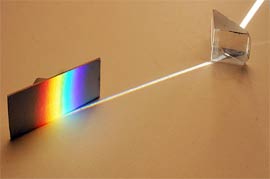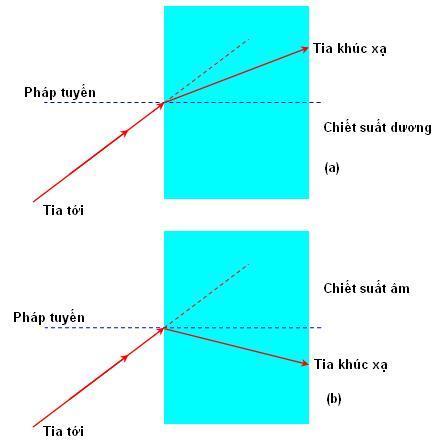Negative refractive index in iron materials from natural metal in high frequency range
 Physicists in Germany claim they have for the first time discovered a material with a natural negative refractive index, instead of the usual positive refractive index.
Physicists in Germany claim they have for the first time discovered a material with a natural negative refractive index, instead of the usual positive refractive index.
Materials with this negative refractive index (a metal conductive ferromagnetic material) are very different from previously known negative refractive materials, which only have a completely artificial structure in the laboratory. And having a negative refractive index until the frequency range GHz can be used in many new components such as super lenses . These details can be seen in the work just published in Physical Review Letters. 98 (2007) 197401.
Anyone after learning basic optical courses knows light refraction, which is the phenomenon of light being broken when passing through the interface between two different optical environments. together. And the normal phenomenon known as a positive refractive index is commonly known as a light traveling in the air when projected to a glass block under a certain angle will be bent toward the normal.
But in 1968, Russian physicist Victor Veselago showed that if both the magnetic permeability and the dielectric constant of the material were negative, refraction would change, now the effect would appear. " negative refraction, where the refractive ray will not travel like refracted rays in ordinary refraction, but be bent towards the other side of the normal (see Figure 1-b).

Figure 1. Light refraction phenomenon with positive refractive index (a) and negative refractive index (b).
Devices that exploit this effect to this day (such as high-resolution superlenses) use artificially created materials in laboratories and purses. for example, arranging bronze rings or bars. The reason is simply because materials have a negative permeability and negative dielectric constant at the same time not found in nature.
But recently, the group of Andrei Pimenov (University of Würzburg, Germany) and some colleagues in other places in Germany have shown that it is possible to create negative refractive index effects in metallic ferromagnetic materials. and even in natural materials.
Pimenov's group was initially skeptical about ferromagnetic materials that could have negative refractive index after testing materials containing ferromagnetic and superconducting layers last year. They discovered surprisingly that these materials exhibited a weak negative refractive index if the superconducting layers were in a normal conductive state and if a magnetic field was placed to keep the ferromagnetic state in a " resonant " state. "ie when the magnetic moments rotate at the same frequency as the light frequency. This prompted them to look for negative refractive index properties in homogeneous ferromagnetic materials.

Figure 2. The temperature dependence of conductivity and from the temperature to the temperature of La2 / 3Ca1 / 3MnO 3 film - below the Curie temperature, the conductivity is metallic (Theo Phys. Rev. Lett. 98 (2007) 197401 ).
The group produces a ferromagnetic metal film La2 / 3Ca1 / 3MnO 3 (membrane material perovskite) and measures the change in amplitude and phase of light when transmitted through the membrane using interferometers. In addition to the material La2 / 3Ca1 / 3MnO 3 , this is not a metallic material, but a ceramic material, with perovskite structure, has a very special property. Magnetic properties, electrical properties of materials can change in many states at different temperatures. And below the Curie temperature, it is ferromagnetic and has a metallic conductivity, so it is called " ferromagnetic - metal " (not to be confused with metals like other ferromagnetic metals).
There has been a research team in Vietnam that successfully created this material with the effect of giant heat in low magnetic fields (see TD Hiep, N. Chau et al. In: Proceedings of the Ninth Vietnam Biennial Conference on Radio and Electronics ( REV'04), November 26–27, 2004, Hanoi, Vietnam, p. 339). It should be noted that the structure here is natural because there are no interventions to form the structure.
After analyzing the results, the group calculated the permeability as well as the dielectric constant of the film, and thus accurately determined the refractive index of the film. In the frequency range up to 150 GHz, they found that the refractive index of the film becomes negative, but this effect disappears when the frequency of light increases to a larger frequency range .

Figure 3. Dependence of refractive index, absorption coefficient and permeability variation of La2 / 3Ca1 / 3MnO3 membrane on magnetic field and temperature (According to Phys. Rev. Lett. 98 (2007) 197401).
Pimenov said that the ferromagnetic - metal materials could in principle have a negative refractive index effect in the frequency range up to 1 THz. However, he also added that such materials would not be as effective as the negative refractive index effect (above 450 THz), which could eliminate them in optical lenses. However, Pimenove said that his team will continue to test this property in a variety of materials including iron, hoping to achieve the negative refractive index effect when in resonance at higher frequencies. 150 GHz, will be very useful for communication devices.
The Doctrine of Independence
According to Physcal Review Letters & PhysicsWeb.org, Vietnamese Physics
- New metamaterials come near stealth technology
- The development of materials
- Can any metal be magnetized like a magnet?
- Detecting new transformation metal
- Terahertz frequency generator (THz) uses high temperature superconducting materials.
- The magic of the first water-immiscible metal in the world
- Solve the most spooky metal series in the world
- New material from natural substitute plastics
- Physicists have created 'impossible metal'
- Miraculous fish fever in Cambodia
- Boeing uses the world's lightest metal on aircraft
- Liquid Metal: A new evolution of 3D printing
 Daily use inventions come from universities
Daily use inventions come from universities Special weight loss device helps prevent appetite
Special weight loss device helps prevent appetite 8 inventors were killed by their own inventions
8 inventors were killed by their own inventions Iran invented a motor car powered by water
Iran invented a motor car powered by water